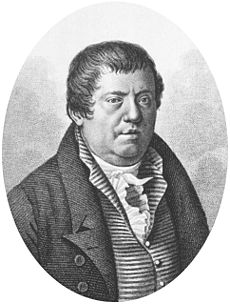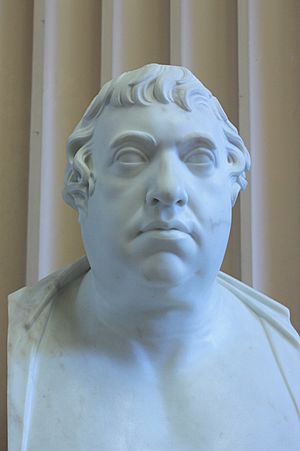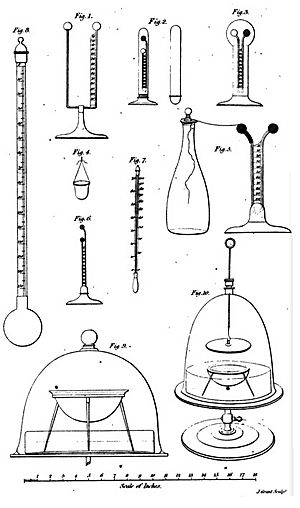John Leslie (physicist) facts for kids
Quick facts for kids
John Leslie
|
|
|---|---|

John Leslie
|
|
| Born | 10 April 1766 Largo, Fife
|
| Died | 3 November 1832 (aged 66) |
| Nationality | British |
| Known for | Studies of heat Leslie cube |
| Awards | Rumford Medal (1804) |
| Scientific career | |
| Fields | Mathematics Physics |
| Influences | David Hume |

Sir John Leslie (born April 10, 1766 – died November 3, 1832) was a Scottish mathematician and physicist. He is famous for his important work on heat.
In 1802, Leslie was the first to explain how liquids move in narrow spaces. This is a process called capillary action. Later, in 1810, he used an air-pump to freeze water. This was the first time ice was made artificially by people!
In 1804, he did experiments with radiant heat (heat that travels like light). He used a special box called a Leslie cube. This cube had different sides: one shiny, two dull, and one painted black. He found that the black side gave off the most heat, and the shiny side gave off almost none.
Contents
Early Life and Education
John Leslie was born in Largo, Fife, Scotland. His father, Robert Leslie, was a carpenter. John went to school in Largo and Leven.
When he was 13, friends noticed how good he was at math and science. They encouraged him to go to the University of St Andrews. He finished his studies there in 1784. After that, he studied to become a minister at the University of Edinburgh, but he did not get any more degrees.
From 1788 to 1789, he worked as a private teacher for a family in Virginia, USA. Then, from 1791 to 1792, he taught for Josiah Wedgwood's family in England. While working, he also did his own science experiments. He translated a book called Natural History of Birds by Buffon, which was published in 1793. This translation helped him earn some money.
Important Discoveries
For the next 12 years, John Leslie continued his science studies. He wrote many papers for a science magazine called Nicholson's Philosophical Journal. In 1804, he published his book, Experimental Inquiry into the Nature and Properties of Heat. This book won him the Rumford Medal from the Royal Society of London.
In 1805, he became a professor of mathematics at the University of Edinburgh. Some people tried to stop him because they disagreed with his ideas. But he still got the job.
While teaching math, he wrote two books about mathematics:
- Elements of Geometry, Geometrical Analysis and Plane Trigonometry (1809)
- Geometry of Curve Lines (1813)
In 1810, he invented a way to make ice artificially. He wrote about this in his 1813 book, A Short Account of Experiments and Instruments depending on the relations of Air to Heat and Moisture. In 1818, he wrote about how cold air from high up in the sky affects us. He also invented a tool called the aethrioscope to measure this.
In 1807, he became a member of the Royal Society of Edinburgh.
Later Career and Legacy
In 1819, John Leslie became a professor of natural philosophy. This job was a better fit for him, and he held it until he died. In 1820, he published a famous book about multiplication called The Philosophy of Arithmetic. In 1823, he started writing a book called Elements of Natural Philosophy, but he never finished it.
Leslie's most important contributions to physics came from using his special tool, the differential thermometer. He improved this tool in many clever ways. He used it to study:
- Photometry: How light works.
- Hygroscopy: How moisture is in the air.
- The temperature of space.
In 1820, he became a member of the Institute of France. This was an honor he truly valued. In early 1832, he was given the title of "Sir."
In his final years, he lived at 62 Queen Street in Edinburgh. John Leslie died in November 1832 from typhus, a serious illness. He was 66 years old.
Family Life
John Leslie never married and did not have any children.
His nephew, James Leslie, was a civil engineer. James was the son of John's brother, Alexander Leslie, who was an architect. John's great-nephew, Alexander Leslie, was also an engineer.
Images for kids





